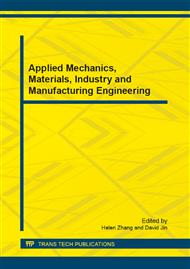[1]
Henderson, A.D. and A.H. Demond, Long-term performance of zero-valent iron permeable reactive barriers: A critical review. Environmental Engineering Science, 2007. 24(4): pp.401-423.
DOI: 10.1089/ees.2006.0071
Google Scholar
[2]
Della Rocca, C., V. Belgiorno, and S. Meric, Overview of in-situ applicable nitrate removal processes. Desalination, 2007. 204(1-3): pp.46-62.
DOI: 10.1016/j.desal.2006.04.023
Google Scholar
[3]
Liang, L.Y., et al., Geochemical and microbial reactions affecting the long-term performance of in situ iron barriers,. Advances in Environmental Research, 2000. 4(4): pp.273-286.
DOI: 10.1016/s1093-0191(00)00026-5
Google Scholar
[4]
Till, B.A., L.J. Weathers, and P.J.J. Alvarez, Fe(0)-supported autotrophic denitrification. Environmental Science & Technology, 1998. 32(5): pp.634-639.
DOI: 10.1021/es9707769
Google Scholar
[5]
Yamashita, T. and R. Yamamoto-Ikemoto, Phosphate removal and sulfate reduction in a denitrification reactor packed with iron and wood as electron donors. Water Science and Technology, 2008. 58(7): pp.1405-1413.
DOI: 10.2166/wst.2008.728
Google Scholar
[6]
Cornell, R.M. and U. Schwertmann, The iron oxides : structure, properties, reactions, occurrences, and uses. 2nd, completely rev. and extended ed. 2003, Weinheim: Wiley-VCH. xxxix, 664 p.
Google Scholar
[7]
Rittmann, B.E., et al., Capturing the lost phosphorus. Chemosphere, 2011. 84(6): pp.846-853.
DOI: 10.1016/j.chemosphere.2011.02.001
Google Scholar
[8]
Rentz, J.A., I.P. Turner, and J.L. Ullman, Removal of phosphorus from solution using biogenic iron oxides. Water Research, 2009. 43(7): p.2029-(2035).
DOI: 10.1016/j.watres.2009.02.021
Google Scholar
[9]
Biswas, S. and P. Bose, Zero-valent iron-assisted autotrophic denitrification. Journal of Environmental Engineering-Asce, 2005. 131(8): pp.1212-1220.
DOI: 10.1061/(asce)0733-9372(2005)131:8(1212)
Google Scholar
[10]
Shin, K.H. and D.K. Cha, Microbial reduction of nitrate in the presence of nanoscale zero-valent iron. Chemosphere, 2008. 72(2): pp.257-262.
DOI: 10.1016/j.chemosphere.2008.01.043
Google Scholar
[11]
Huang, C.P., H.W. Wang, and P.C. Chiu, Nitrate reduction by metallic iron. Water Research, 1998. 32(8): pp.2257-2264.
DOI: 10.1016/s0043-1354(97)00464-8
Google Scholar
[12]
Della Rocca, C., V. Belgiorno, and S. Meric, An heterotrophic/autotrophic denitrification (HAD) approach for nitrate removal from drinking water. Process Biochemistry, 2006. 41(5): pp.1022-1028.
DOI: 10.1016/j.procbio.2005.11.002
Google Scholar
[13]
Oikonomidis, I., L.J. Burrows, and C.M. Carliell-Marquet, Mode of action of ferric and ferrous iron salts in activated sludge. Journal of Chemical Technology and Biotechnology, 2010. 85(8): pp.1067-1076.
DOI: 10.1002/jctb.2399
Google Scholar


